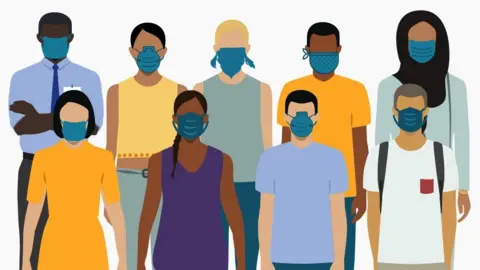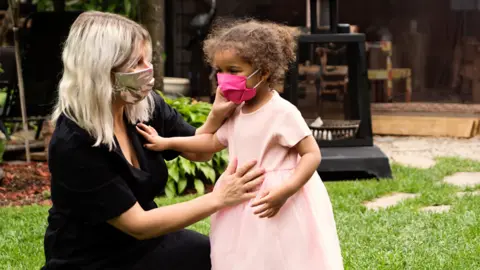Coronavirus: A user's guide to wearing a face mask to the shops
 BBC
BBCThere is now almost no excuse for not wearing a face mask while out shopping in England - covering your face is as essential as remembering your cash or bank card.
The rules differ a little around the UK. But wherever you live, it's going to be hard to avoid covering up your mouth and nose. And that raises a host of dilemmas.
How do I put it on correctly?
This is important to get right. The key things are to clean your hands before you put it on and take it off, and to make sure it fits snugly so there aren't any gaps between the material and your face.
Of course if your mask doesn't fit properly you can always adjust it, or tie it in a slightly more convenient way. But it needs to cover both your mouth and nose and also go up to the top of your nose, hooking behind your ears or the back of your head.
And remember, the idea is no gaps. Got it? You're good to go.
Deciding on the right one
When buying your mask the first thing you need to decide is what sort you want. The government says surgical masks and respirators should be reserved for those who need them to protect against risks in their workplace, such as NHS staff and care workers.
But you can still buy non-medical disposable face coverings, reusable cloth coverings, or even items like scarves and bandanas.
If single-use coverings are what you're after, you could head to a pharmacy - high street chains like Boots, Superdrug and Lloyds all sell them. And they're available on online sites like Amazon.


But more and more clothes retailers are also joining the marketplace with reusable fabric masks. In fact, it seems everywhere now sells reusable masks - from your local corner shop, to your favourite football club, to independent retailers on Etsy.
From ditsy designs to animal prints, there are a range of "fashion masks" on sites like Asos or Boohoo, or in shops like Oliver Bonas.
Can I take it off to talk?
No, sorry, that's not allowed. Coronavirus is spread when droplets are sprayed into the air when infected people cough or sneeze - but also when they talk. Those droplets can then fall on surfaces.
So it would defeat the point if you take it off to have a natter, really.
How to stop it fogging up my glasses
It's a worry that has been burdening many spectacle-wearers. It's a legitimate one, too - lenses can steam up when you wear a mask because your warm breath comes out of the top of the mask, hitting the cooler lenses and clouding them up.
The extra moisture can also mean that nose pads become slippery and your frames glasses slide down your face.
The key is to try, if possible, to make sure there aren't any gaps for the air to escape around your nose and cheeks. You could try tucking the mask behind your glasses, or tucking some tissue inside the top of the covering.
The opticians Specsavers recommends resting your glasses on top of your mask to help seal any gap, or using a piece of surgical tape to secure the mask to the bridge of your nose.
Failing that you could try washing your glasses in soapy water to stop them misting up.
What about my medical conditions?
A face covering should cover your mouth and nose while allowing you to breathe comfortably. But if you have a medical issue and suffer from breathing difficulties, it might not be quite that simple.
You may well already be among those exempt from wearing face coverings on public transport in England. The government hasn't given the precise wording of the rules for shops yet, so you'll need to check those once they're out.
But one tip from Asthma UK is to try a few different types to see if there is one that suits you. It suggests trying one out at home, or on a short walk around the block before heading off to do your weekly shop.
So how about recycling them?
No, sorry (again). If your mask isn't washable, or if it's disposable, the government says it should go in your "black bag" or general waste bin (or a litter bin if you're outside) once you've worn it.
Disposable face coverings should be thrown away after each use, or as soon as they are damp, according to the World Health Organization. This includes the lighter, pleated ones as well as the sturdier, particle-filtering masks.
The added waste has caused concern for environmentalists who say they're ending up in the sea.
The government says if you're worried about this you can "wash and reuse cloth face coverings", or make your own.
Making my own mask
Whether you're handy with a sewing machine, you like cutting up old t-shirts, or just want a quick fix, the principles are the same: the more layers of material the better, and the mask needs to fit snugly around the face, and allow you to breathe comfortably.
One study suggests the best materials to use are tightly-woven cottons or twill, natural silk or quilted cotton material. But you can also make do with what you have around your home.
We've put together a guide to different types and step-by-step instructions on how to make them.
Making sure you wash it
You should wash your fabric coverings after every use. That might sound like a lot, but the good news is you can put them in the washing machine with the rest of your clothes.
Bandanas, face scarves and coverings made of fabric, like cotton, can be washed in your regular laundry using hot water, says US-based Johns Hopkins Medicine.
You should wash it on the warmest appropriate water setting, but that depends on the type of material it's made from. Or you can hand wash them in hot, soapy water - scrubbing them for at least 20 seconds.
After washing, tumble dry them on a high setting and store in a clean place. If you are air drying, keep them flat and try to dry them in direct sunlight. Johns Hopkins Medicine also suggests using a non-scented detergent if you are sensitive to perfumes.
Finding the right size for my child
 Getty Images
Getty ImagesSome big high street names (Gap, Boots, Claire's to name just three) sell masks for children, alongside smaller manufacturers that have shifted their focus - including Thumbsie, which usually makes fabric gloves to help children stop sucking their thumbs.
Vistaprint offers a range of face coverings with adjustable straps in kid-friendly fabrics, while luxury brand Rachel Riley makes them with a cotton satin lining for children as young as three.
In England, only children aged 11 and over will have to wear one in shops. In Scotland, all children aged five and over must cover their faces in shops.
Treating my mask like my socks
Some people have said you should think of your masks like your socks - having a new one every day.
That doesn't mean you need to rush out and buy dozens of them, but it's a good idea to perhaps have more than one. That way you can wear a clean one while the other is in the wash.
And as for the disposable ones, they are usually sold in large numbers - Boots, for example, has a multipack of 80. That should be more than enough to do the weekly supermarket shop for a few weeks.

- A SIMPLE GUIDE: How do I protect myself?
- HOPE AND LOSS: Your coronavirus stories
- LOOK-UP TOOL: Check cases in your area
- VIDEO: The 20-second hand wash

